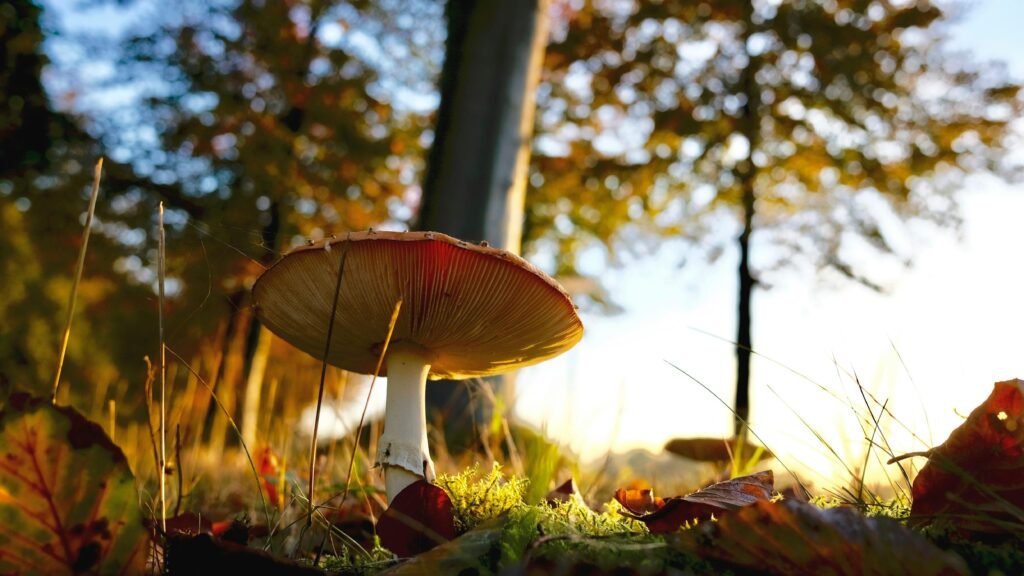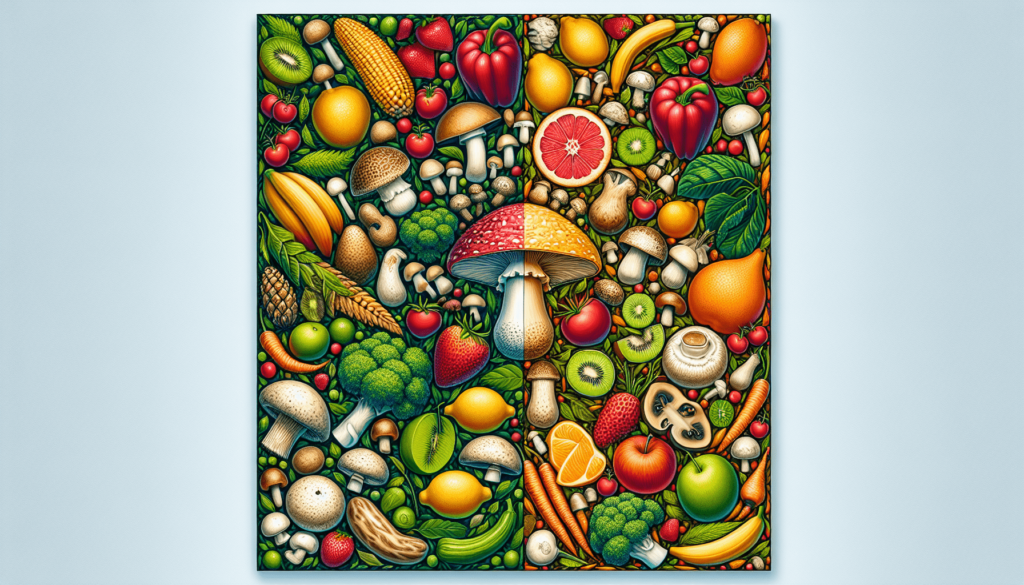Ever wondered about the mysterious classification of a mushroom? You’re not alone. Exploring the fascinating world of culinary distinctions, this article seeks to shed light on the ambiguous nature of mushrooms and determine whether they belong to the fruit or vegetable category. Embark on this delightful exploration and uncover the truth behind this intriguing botanical riddle. Prepare to unravel the secrets of mushrooms and discover where they truly belong in the spectrum of edible wonders.

Definition of a fruit and a vegetable
Botanical definition
In botanical terms, fruits are the mature ovaries of flowering plants that contain seeds. They develop from the flower and serve as a means of seed dispersal. On the other hand, vegetables are the edible parts of plants that do not contain seeds, such as leaves, stems, and roots. These definitions are based on the botanical characteristics and biological functions of these plant parts.
Culinary definition
From a culinary perspective, fruits are usually defined as sweet or dessert-like products that are consumed fresh or used in sweet dishes. Common examples include apples, oranges, and berries. Vegetables, on the other hand, are often considered savory and are frequently used in savory dishes, such as salads, stir-fries, and soups. Examples of vegetables include carrots, broccoli, and spinach.
Differentiation between fruits and vegetables
While there are clear definitions from a botanical and culinary perspective, the differentiation between fruits and vegetables can sometimes become blurred. This is where mushrooms come into play, as they do not fit neatly into either category. These unique organisms have distinctive characteristics that set them apart from traditional fruits and vegetables.
Mushroom classification
Fungal nature of mushrooms
Mushrooms belong to the fungi kingdom, making them distinctly different from plants. Fungi are a group of organisms that obtain nutrients by breaking down organic matter in their environment. Unlike plants, mushrooms do not have chlorophyll and cannot produce their own food through photosynthesis. Instead, they rely on a complex network of mycelium, which is the fungal equivalent of roots, to extract nutrients from their surroundings.
Fruit bodies of fungi
One of the defining features of mushrooms is their fruiting bodies. These structures, also known as mushrooms or basidiocarps, are the visible part of the fungi. They typically consist of a cap, a stalk, and gills or pores underneath the cap. The fruiting bodies serve the purpose of producing and dispersing spores, which are the reproductive cells of the fungi.
Similarities with fruits
Interestingly, mushrooms share some similarities with fruits. Just like fruits, mushroom fruiting bodies are the result of the reproductive process. Both fruits and mushroom fruiting bodies are involved in the dispersal of reproductive cells. However, while fruits primarily disperse seeds, mushroom fruiting bodies disperse spores.
Mushroom characteristics
Absence of seeds
One noticeable characteristic that sets mushrooms apart from traditional fruits is the absence of seeds. While fruits develop from fertilized flowers and contain seeds, mushrooms do not go through this process. Instead, mushrooms reproduce through the release of spores from their fruiting bodies.
Spore-bearing structures
As mentioned earlier, the gills or pores on the underside of a mushroom’s cap are responsible for producing and releasing spores. Spores are microscopic reproductive cells that are carried by air currents or other means to new locations, where they can germinate and form new mycelium.
Lack of sweetness
Another distinguishing characteristic of mushrooms is their lack of sweetness. Unlike many fruits, which are known for their sweet and flavorful taste, mushrooms have a more earthy and savory flavor profile. This makes them a popular ingredient in savory dishes, where they add depth and umami to the flavor.
Cooking and culinary uses
Mushrooms have been used in cuisine for centuries and are appreciated for their unique texture and flavor. They can be consumed raw or cooked, and their versatility allows them to be used in a wide variety of dishes. Mushrooms are often sautéed, grilled, or added to soups, stews, pasta dishes, and pizzas to enhance their taste and texture.
Fruits vs Vegetables
Botanical perspective
From a botanical perspective, mushrooms are neither fruits nor vegetables. While fruits develop from the ovaries of flowering plants, and vegetables encompass various other plant parts, mushrooms belong to a completely different biological kingdom: Fungi.
Culinary perspective
Culinarily speaking, mushrooms are often grouped together with vegetables due to their savory and versatile nature. However, they do not fit the traditional definition of vegetables, as they lack the botanically defined characteristics of vegetables such as leaves, stems, or roots.
Legal perspective
The legal classification of mushrooms varies depending on the jurisdiction. In some countries, mushrooms are treated as a separate entity and have their own regulations and standards. In other cases, they may be classified as vegetables for regulatory purposes. The legal classification often depends on the specific laws and regulations of each country or region.

Botanical perspective
Fruit classification
In botanical terms, fruit is classified as the mature ovary of a flowering plant that contains seeds. This definition encompasses a wide range of fruits, including apples, oranges, tomatoes, and bananas. However, mushrooms are not considered fruits because they do not develop from the ovaries of flowering plants.
Seed-bearing structures
Fruits typically contain seeds, which are formed from fertilized ovules within the ovary. These seeds can be dispersed by various means, such as wind, water, or animals. Mushrooms, on the other hand, do not produce seeds. Instead, they produce spores as a means of reproduction.
Fruit-bearing plants
Fruit-bearing plants are typically trees or flowering plants that produce fruits as part of their reproductive process. These fruits attract animals that eat them and disperse the seeds in their droppings. Examples of fruit-bearing plants include apple trees, grapevines, and strawberry plants. Mushrooms, as fungi, do not fall into this category.
Mushroom classification
Mushrooms are classified as fungi, which is a distinct kingdom separate from plants. Fungi encompass a wide range of organisms, including mushrooms, molds, and yeasts. While they have some similarities with fruits, such as being involved in the reproductive process, mushrooms are not classified as fruits due to their different biological and structural characteristics.
Culinary perspective
Categorization based on taste
From a culinary perspective, mushrooms are often categorized with vegetables based on their taste and usage in dishes. They have a savory and umami flavor, similar to many vegetables, which makes them a popular ingredient in savory dishes such as stir-fries, soups, and sauces. However, mushrooms can also have a meaty and robust texture, which further distinguishes them from traditional vegetables.
Usage in savory and sweet dishes
While fruits are typically associated with sweet dishes, mushrooms are predominantly used in savory dishes. They can be sautéed, roasted, or grilled to enhance their natural umami flavor and provide a meaty texture. However, there are also examples of mushrooms being used in sweet dishes, such as desserts or confections made with medicinal mushrooms like Reishi or Chaga.
Mushroom placement
In culinary contexts, mushrooms are often found in the produce section alongside other vegetables. This placement can be attributed to their usage in savory dishes and their similar culinary characteristics. However, it is important to note that mushrooms are not botanically classified as vegetables.

Legal perspective
Regulation and classification
The regulatory classification of mushrooms varies around the world. In some countries, mushrooms are classified separately from fruits and vegetables and may have their own regulations regarding cultivation, handling, and marketing. In other cases, they may fall under the umbrella of vegetables for legal purposes. The specific regulations depend on the laws and standards of each country or region.
Governmental definitions
Governmental agencies in different countries often have their own definitions and classifications for fruits, vegetables, and mushrooms. These definitions can vary depending on factors such as cultural traditions, agricultural practices, and trade regulations. It is essential for growers, distributors, and consumers to be aware of the specific definitions and regulations in their respective jurisdictions.
Categorization in trade and commerce
In the trade and commerce of fruits and vegetables, mushrooms are often grouped and marketed alongside vegetables due to their culinary usage and similarities. They are typically sold in produce sections of supermarkets and farmers’ markets, further reinforcing the association with vegetables. However, from a botanical perspective, mushrooms remain distinct from fruits and vegetables.
Mushroom misconceptions
Confusion with vegetables
One common misconception is that mushrooms are vegetables. This confusion arises from their culinary usage and placement in the produce section alongside traditional vegetables. However, as discussed earlier, mushrooms are neither fruits nor vegetables from a botanical perspective. Educating consumers about the distinct classification of mushrooms can help dispel this misconception.
Mislabeling in supermarkets
Another potential source of confusion is the mislabeling of mushrooms in supermarkets. Due to their similarity in culinary usage, there may be instances where mushrooms are incorrectly labeled as vegetables. This can contribute to the perception that mushrooms are a type of vegetable. Quality control measures and accurate labeling are necessary to ensure that consumers have accurate information about the products they are purchasing.
Educational awareness
To address these misconceptions, educational awareness about the classification of mushrooms is crucial. This can be done through public campaigns, educational materials, and clear labeling. By providing accurate information about the biological and culinary characteristics of mushrooms, consumers can make informed decisions when it comes to purchasing and using these unique fungi.

Conclusion
Multiple perspectives
The debate over whether mushrooms are fruits or vegetables highlights the complexities of classification in the natural world. From a botanical perspective, mushrooms are neither fruits nor vegetables, as they belong to the fungi kingdom. However, from a culinary perspective, mushrooms are often grouped together with vegetables due to their savory and versatile nature.
Food industry implications
The classification of mushrooms has implications for various sectors of the food industry, including agriculture, marketing, and regulation. Proper classification and labeling of mushrooms are necessary to avoid confusion and ensure accurate representation of the products. This allows consumers to make informed choices and supports fair trade practices.
Appreciating the uniqueness of mushrooms
Rather than getting caught up in the debate of whether mushrooms are fruits or vegetables, it is more important to appreciate the uniqueness and diversity of mushrooms. Their distinctive characteristics, including their fungal nature, spore-bearing structures, and versatility in culinary applications, make them a fascinating addition to our diet and culinary traditions.
